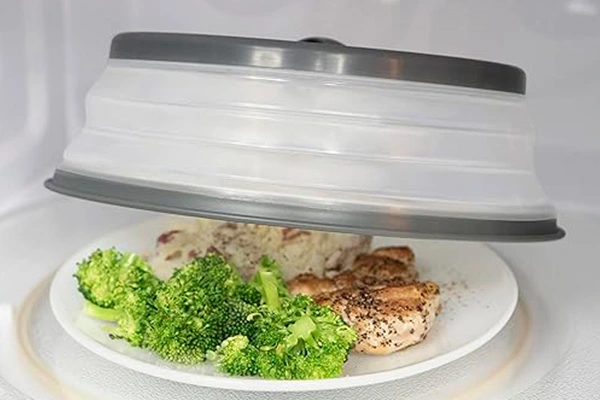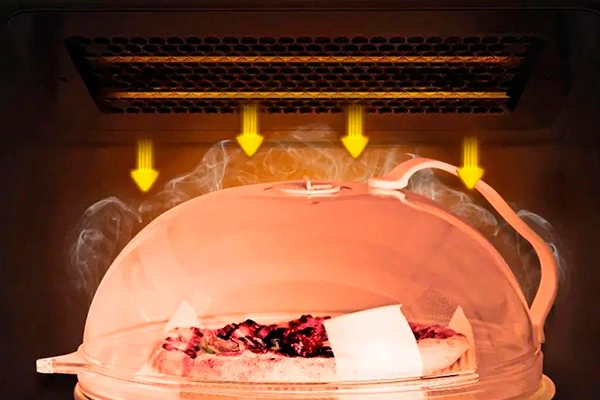Food containers in the microwave oven are covered with a dish cover. Microwave dish covers have many uses:
- They keep microwaves clean by preventing spills.
- They keep meals wet and hot throughout cooking.
- They prevent food contamination.
- They simplify some cooking.
- They help cook food evenly.
Covers are used to prevent spills, retain steam, and cook food evenly. Soups, sauces, oats, and veggies explode and splatter; thus, covers are necessary. Read on to discover what is the purpose of the microwave dish cover.
Table of Contents
What Is The Purpose Of The Microwave Dish Cover?
Protect Against Messes and Splatter
A microwave dish cover prevents food splatter and spills in your microwave. When cooking soups, sauces, or other moist meals in the microwave, popping and bubbling can cause food to splash up and mess up the walls and roof. It can be messy and requires microwave cleaning. To keep your microwave clean, a cover keeps food spattering under the lid. It protects the dish from spills. This reduces microwave inside cleaning. Covering the microwave prevents food splatter, keeping it clean longer.
Retain Moisture and Heat
A microwave dish cover keeps food moist and hot. Steam cannot escape the dish since the cover seals it. Steam condenses inside the cover and drips onto the food, keeping it moist and heated.
Steam would escape without a cover. A microwave without a cover dries food quickly since it doesn’t trap moisture. Without moisture, meats become rough and chewy while veggies become limp and sloppy.
A cover lets steam return to the food, producing a moist heating environment. More fluids are retained as food cooks tenderly.
After microwaving, the lid keeps heat localized, keeping food hotter longer. Covered dishes maintain heat longer. This keeps food hot and ready to eat after microwaving.

Avoid Contamination
The microwave cover prevents food contamination. Grease, oil, liquids, crumbs, and other food particles can mess up a microwave without a cover. This buildup can cross-contaminate food and dishes over time.
Covering your food protects it from the filthy microwave interior. This prevents particulates, bacteria, and residue from previous meals from contaminating freshly cooked food. A clean cover keeps dust and pet dander out of your dish.
So the microwave cover helps ensure food safety by creating a controlled, hygienic microwave cooking environment. It protects food from outside elements that could ruin taste, quality, or safety. To prevent bacteria from spreading, wash the cover often.
Make Cooking Easier
Microwave dish covers simplify cooking. The cover can cover containers without lids. This lets you prepare microwave meals without dirtying any microwave plates, which leads to finding the correct lid.
The cover makes finding the right lid easy when heating leftovers in a bowl or cooking a fresh meal in a microwave-safe dish. Paper towels and plastic wrap are no longer needed to cover foods. Universal microwave cover is a one-stop shop.
If you want to simplify microwave cooking, use a dish cover. Put it over any bowl or dish to microwave. It streamlines cooking so you can heat meals quickly.
Even Heating
Microwave dish covers reflect microwaves to evenly cook food. Some food cooks faster in microwaves without covers. This uneven heating causes chilly and overdone patches.
The cover prevents direct access to a microwave energy source. Before reaching food, microwaves bounce and reflect off their interior surface. This reroutes microwaves to enter food from all sides. More uniform microwave exposure reduces hot and cold areas, cooking the food evenly.
Microwave energy spreads best with a dome-shaped cover. Similar to downwards, the curved lid reflects microwaves to the dish sides. This gives food even, complete cooking energy for the best results.

Types of Microwave Covers
The following microwave covers are common:
Plastic Covers
Plastic microwave covers are widespread and typically supplied. They are cheap, lightweight, and functional. Most plastic lids contain vents or holes to release steam during cooking. The biggest drawback is that intense heat can deform, discolor, or melt plastic.
Glass Covers
Glass covers are stronger and more heat-resistant than plastic. While keeping moisture and heat, they let you monitor food cooking. Special coatings on glass lids reflect microwave radiation uniformly. The biggest issue is their weight and breakability if dropped.
Silicone Covers
Lightweight and flexible silicone covers are ideal for bowls and dishes. About 500°F is their heat resistance. Silicone minimizes splatters, conforms to containers, and works in the microwave and oven. The primary drawback is that silicone does not hold heat or moisture like glass or plastic covers.
Which Foods Benefit Most from a Microwave Cover?
Certain foods benefit best from microwave covers. Covers keep soups, stews, and porridge hotter and steamier. Protecting foods that explode and splatter during cooking is also important. This contains eggs, tomatoes, rice, popcorn, and hotdogs. A splatter guard keeps microwaves clean during cooking. Covers keep baked potatoes, veggies, seafood, and leftovers moist and warm evenly. Microwave dish covers help with any cuisine that needs mild heating or wetness.
Tips for Effective Use
The microwave dish cover is useful, but it must be used properly. Here are some tips:
- Leave a tiny opening while covering food. This lets excess steam escape instead of collecting on the cover and dripping onto food. Soggy food is avoided via venting.
- Cover only for a minute or two of cooking. Extended microwave cooking traps steam and soddens food. Covers are used to maintain early wetness.
- Avoid touching the food with the cover. Proper steam ventilation is achieved.
- Plastic covers are lighter than glass or ceramic. Lighter materials penetrate microwaves better for even heating.
- Follow manufacturer’s ventilation and cooking time guidelines on the cover.
- Covers with metal trims or decorations can arc in the microwave. Make sure your cover is microwave-safe.
- Keep coverings clean between uses and replace warped or broken ones. Continued safety is assured.
Use these easy strategies to maximize your microwave dish cover! Effective cooking requires leaving a vent, short cooking times, and lighter covers.
Conclusion
Use a microwave cover for various reasons. To conclude, a microwave cover prevents spatter and spills, retains moisture and heat, prevents food contamination, simplifies cooking, and promotes even heating.
A microwave cover keeps your microwave clean, prevents moisture loss, ensures food is completely cooked, simplifies cooking, and improves dish texture and taste. Foods containing sauce or liquids reheat better with covers. A cover prevents food explosions, pops, and splatters when heating. The lid traps debris and steam, preserving flavors, textures, and wetness.
In general, microwave covers help microwave cooking. Using a vented cover for a few seconds can improve microwaved meals and snacks.
